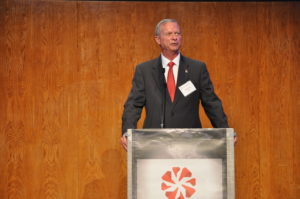Killalea retires from IADC with legacy of leadership and innovation
Achievements over 28 years include pioneering of World Drilling, ART Committee and leadership of Drilling Contractor magazine, multimedia growth
By Sarah Junek, Associate Editor
After 28 years with IADC, Mike Killalea is retiring in March, leaving a legacy of mentorship and innovation. Mr Killalea joined the association in 1991 as Associate Editor of Drilling Contractor magazine and retires as Group Vice President and Editor/Publisher. His years at IADC reflect an unending energy for chasing good opportunities and trusting one’s instincts.

Mr Killalea’s life has been marked by combined passions for science and the written word. After his service in the US Navy, Mr Killalea earned a degree in chemical engineering from the University of California at Davis in 1980. A year later he joined Exxon Production Research Corp, working on reservoir simulation models of Saudi Arabian oil fields for five years until leaving to follow the call of the word.
“I found that engineering, while interesting, wasn’t really where I wanted to be.” He began writing for newspapers and for trade publications, on subjects as far ranging as banking and credit unions to enhanced oil recovery and drilling. He served as editor for Dallas-based Drilling Magazine in the late 1980s, with the industry still reeling from the oil price collapse of 1986. The unrelenting downturn led to the shuttering of that magazine in 1989. “I have the dubious distinction of serving as the last editor of Drilling Magazine,” Mr Killalea said dryly.
During the nearly 30 years he spent at IADC, the industry has undergone sweeping and unexpected trends, he remarked. “When I started with IADC, the industry was largely dominated by North American land drilling contractors,” he recalled. “The offshore sector exploded into ever-deeper water, while the land business was yesterday’s news.”
Then came the shale revolution.
“And now, lo and behold, 28 years later, we’re once again an industry dominated by North American land drillers,” he said. “We’ve come full circle.”
In 1994, he was named Editor and Publisher of Drilling Contractor. “By this time, IADC was becoming much more global in scope,” Mr Killalea recalled. “IADC elected its first non-US Chairman in 1991. Today, we have an entire department dedicated to international development, led by Mike DuBose, IADC Vice President-International Development.”
IADC now convenes a third of its conferences outside the US, and nearly half of Drilling Contractor’s readers reside outside North America.
Other significant changes he has followed include the evolution of PDC bits into the dominant bit type, the move into deepwater drilling, the growing adoption of managed pressure drilling and the drilling automation revolution.
“It’s been an interesting ride in an industry with ever-changing economic fortunes, yet oddly static operations, technology and business models,” Mr Killalea observed. “I’ve enjoyed learning about steadily evolving drilling technology over the years, many of them quite significant, but the advent of digital technology might finally give us the impetus to make a real step-change in efficiency and safety through automation in the coming years. It will make for an exciting future.”
What has changed little, though, is the basic industry business model.

“Where we fall behind other industries is the segmentation of our products and services,” he said. “It’s tough to align toward a mutual goal when different sectors are rewarded in different ways. This divergence of interests creates conflict on even basic questions, such as who owns the data from drilling operations.”
If the business model remains flat, industry economics are a nonstop roller coaster, he added. “The continuous up- and downturns have truly shaped the industry’s corporate landscape over the last 30 years. We build during good times, and when a recession inevitably hits, there are few options but to consolidate companies through mergers and acquisitions.”
From 1991 to the present, IADC contractor membership has declined from 400 companies to just 330. “The result is more publicly owned drilling contractors, often with greater capitalization and better wherewithal to weather future market storms,” he said.
Mr Killalea has also had oversight in bringing IADC technical committees together to address issues impacting the industry.
The IADC Advanced Rig Technology (ART) Committee, which was established in 2008, grew from an initial conversation between Mr Killalea and drilling contractors, operators, service companies and manufacturers. In particular, he credits Frank Springett of National Oilwell Varco for his contributions to the nascent ART Committee.
“I’m really happy to have played whatever role I might have in helping develop the new generation here at IADC.” – Mike Killalea
“Our vision,” Mr Killalea explained, “was to create a forum within IADC for all segments of the drilling industry to come together to advance mutually beneficial solutions to the challenges of automation and other advanced drilling topics.”
Over the past decade, the ART Committee has generated technical papers, convened workshops, conducted surveys and developed guidelines for cybersecurity, control motions, alarm management, control valve qualification testing, and more.
Further achievements of the ART Committee include the creation of a cybersecurity workgroup within the Drilling Control Systems (DCS) Subcommittee that ultimately evolved into the IADC Cybersecurity Committee; introduction of the IADC ART Conference; as well as the recent launch of IADC DDR Plus. IADC DDR Plus is a print and electronic data collection system aimed at securing accurate and relevant drilling data that the industry can use to assess performance against drilling key performance indicators. The new system, the first major revamp of the traditional IADC tour sheet in many years, represents a new standard for drilling data recording, facilitating collection of highly granular rig performance information.
As editor and publisher overseeing Drilling Contractor magazine and website content, Mr Killalea has been part of 167 issues of the magazine and 27 IADC Membership Directories. During this time, he’s helped to more than double the circulation of the magazine, build the Drilling Contractor website, launch both DrillBits and eNews from DrillingContractor.org, and established IADC’s Communications team as a leader in video and multimedia content for the drilling industry. “We do close to 100 videos a year now,” he said. “They add a lot of value to the industry.” The magazine also includes QR codes linking print to video content. “We call this Enhanced Editorial,” he said. “It really adds additional dimensions to both our print and electronic content.”
Mr Killalea also noted that he’s particularly proud of his Communications team, particularly the “triumvirate” of Linda Hsieh, formerly Managing Editor and also his successor as Editor & Publisher; Brian Parks, IADC Creative Director; and Anthony Garwick, Director-Web and IT Services. “These three made my job a piece of cake,” he quipped.
DC in 2010 kicked off a program of virtual panel discussions, which have covered critical topics such as API Standard 53, hydraulic fracturing and the digital oilfield. “Our VPDs give its audience a front-row seat to quality, in-depth panel discussions of the highest relevance to our industry” he noted.
Together with Jason McFarland, then Manager of the IADC Bookstore and now IADC President, Mr Killalea in the early 2000s developed the first electronic version of the IADC Drilling Manual, converting the 11th edition of that reference to CD-ROM.

More than a decade later, Mr Killalea directed development of the 12th edition of the IADC Drilling Manual, a nearly total rewrite produced through the collaboration of more than 200 subject matter experts. The 12th edition boasts 26 chapters and nearly 1,200 pages, including several QR links to online videos.
The IADC Bookstore has come a long way since that initial CD-ROM Drilling Manual, 11th edition. Today’s dedicated IADC eBookstore offers a sophisticated e-book of the 12th edition, as well as of all other IADC-published books and guidelines, in addition to traditional print versions.
“I’ve had the honor to have worked with and to have mentored a lot of great people at IADC,” Mr Killalea said. “I’m really happy to have played whatever role I might have in helping develop the new generation here at IADC.”
Mentors he recalls having a profound influence on his career include former IADC President Dr Lee Hunt and 1995 IADC Chairman George S Dotson, then President/COO of Helmerich and Payne International Drilling Co, among other IADC Chairmen.
Mr McFarland said the thing that stands out while working with Mr Killalea is how he always encouraged others to try new things. “That’s one of the things he’s done extremely well, not just for me but for a number of us who have worked for him over the years. Those opportunities were valuable,” Mr McFarland said. The inevitable lessons learned were always supported with a friendly, “How do we change it for the next time around?”
“Had I not had those experiences, I would have been far less equipped to step out and manage on my own.”
Mr Killalea was a pioneer throughout his career at IADC, from establishing IADC World Drilling, which was first held in 2000 in Paris, to more recently the ART Conference, Mr McFarland said.
“One of his greatest strengths is getting something at a root level before there’s even shoots and nurturing it,” he said.
“Often, his projects would then grow into their own and be handed off to other colleagues at IADC. There’s no one better suited for a new kind of initiative, even at the conceptual level just to say, ‘I’d like something like this,’ and then let them run with it,” Mr McFarland said. “That kind of innovation will be missed.” DC





